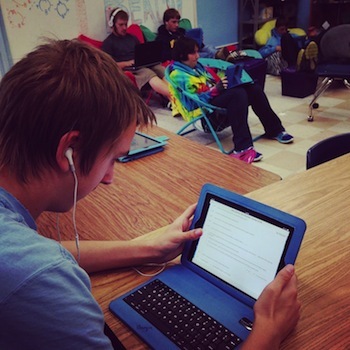
A student recently told me, “This is the only class where I don’t feel like I’m at school.” When I asked her why, she said, “There’s just more room to learn.” It’s comments like these that make me ask myself why I didn’t make the shift to blended learning earlier.
The Power of Connections
Over the past eight years my teaching has evolved from a direct instruction approach, to hands-on inquiry, and now to blended-gamified, consisting of adding game elements into a blended learning environment. When I think about what has pushed me to make this change, many things come to mind. One of the most important steps I’ve taken is to become a connected educator. As a member of the millennial generation, I’ve experienced the power of technology in learning. I’ve embraced the power of connecting globally and have used a variety of tools and platforms to create a strong, professional learning network (PLN). I frequent education Twitter chats, like #MTedchat and #westedchat, as well as communicate via voice using Voxer with educators across the globe. Through connecting via social media, the brick-and-mortar walls of my school have crumbled. I’ve immersed myself in dynamic learning approaches that I strive to implement and adapt for my students in rural Montana. Social media has helped me look at teaching and learning through a whole new lens.
Changing the Look and Feel of Education
This lens has offered greater perspective, both as I reflect on my own practice and as I observe the experiences of others to see what is truly possible in education. I’ve started to see myself as more than just a teacher. I am a divergent innovator looking to make substantial changes in the look and feel of education – and I’m starting with my science students. Most of my students, in my opinion, have a skewed perception of learning and school. They are under the impression that all you do is go to school, do the work, and get a grade. They are compliant and passive learners. I don’t blame them for thinking this is what is needed to succeed. As a change maker, I know learning can be different. For me, it’s about embracing mistakes, taking risks, and failing forward. It’s about my students building skills that are applicable to their chosen careers and futures. It’s about building relationships with their peers and teachers that reinforce positive collaboration and being self-managers of their learning. Students need to feel like their learning is customizable and can be differentiated based on their needs. They need to be able to look at learning through a whole new lens. These are just a few of the reasons I feel blended learning was worth the risk.
Relationships Matter
When I started blending my practice, I didn’t think much about how my relationship with students would be affected; I thought more about the structure, the curriculum, and how I was going to keep my students progressing in a self-paced environment. Unbeknownst to me, relationships are the driver of all things in education, even when technology is added to the equation. Without a positive relationship between my students and myself, authentic learning is impossible. When relationships are established, students do everything in their power to learn the material, not only for the teacher, but for themselves. In my experience, blended learning is a powerful tool for reaching the whole student.
I was once told by a boss that I’m a dreamer. He was right! I have dreams and intentions of turning what is traditional in education upside down. I’d love to work in a school where schedules and bells don’t exist and the role of the teacher shifts to an academic coach. So, what has caused me to make this mindshift? For me, it was connecting with like minded people on Twitter and embedding my practice in blended learning. This methodology has helped me see school and my students through a new lens. It’s given me a clear view of the true purpose of school; helping students be holistically successful. I feel I must do everything in my power to make sure that my students feel like school is worthwhile and not just a chore. If that means my class becomes a disruptive innovation then so be it! I’m willing to take the risk because my students are worth it.
So, are you ready to make the shift to blended learning too?
If so, consider these questions: (1) Are you willing to recreate your classroom while looking through a new lens? and (2) Are you willing to take risks to enhance your students’ learning experience? If you can answer yes to these questions, then you know you’re ready to take on a blended learning approach in your classroom. If not, there are some AMAZING educators out there willing to help you every step of the way. The lens is often clearer when your perspective of school changes, you take the risks, and change how your classroom looks in the end. I guarantee the failures and successes will all be worth it!
Opinions presented in this blog post are those of the author and do not necessarily represent TLA’s opinion, nor should be considered an endorsement by TLA of any organization or product.
